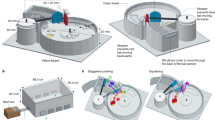Abstract
Parental investment theory suggests that investment by males through courtship feeding of their mates may represent an important source of nutrition which increases female fitness and ultimately influences patterns of sexual selection1,2. In certain insects males provide nutritional products from reproductive accessory glands during mating; these are either eaten by the female or are absorbed in her genital tract2,3. Male bushcrickets (Orthoptera: Tettigoniidae) feed their mates with an elaborate spermatophore consisting of a spermatophylax, which is eaten by the female after mating, and a sperm ampulla, eaten after the ejaculate has emptied4,5. Studies of bushcricket mating systems have indicated that spermatophore nutrients are important to females—females prefer to mate with males able to supply larger spermatophores6—and field studies of species with very large spermatophores have revealed a role-reversal in reproductive behaviour, with females aggressively competing for males capable of producing spermatophores7,8. Although radiolabelling experiments (with several insect species) have demonstrated that male-derived nutrients are incorporated into eggs3,9–11, these studies do not demonstrate that this sort of courtship feeding enhances female fitness. Here I report the results of an experiment which shows that feeding on the spermatophore enhances the reproductive success of female bushcrickets (Requena verticalis Walker) by increasing the numbers and size of eggs produced.
This is a preview of subscription content, access via your institution
Access options
Subscribe to this journal
Receive 51 print issues and online access
$199.00 per year
only $3.90 per issue
Buy this article
- Purchase on Springer Link
- Instant access to full article PDF
Prices may be subject to local taxes which are calculated during checkout
Similar content being viewed by others
References
Trivers, R. L. in Sexual Selection and the Descent of Man, 1871-1971 (ed. Campbell, B.) 136–179 (Aldine, Chicago, 1971).
Thornhill, R. Am. Nat. 110, 153–163 (1976).
Bowen, B., Codd, C. & Gwynne, D. T. Aust. J. Zool. (in the press).
Boldyrev, B. T. Horae ent. Soc. Ross. 41, 1–245 (1915).
Gwynne, D. T., Bowen, B. & Codd, C. Aust. J. Zool. (in the press).
Gwynne, D. T. Anim. Behav. 30, 734–738 (1982).
Gwynne, D. T. in Orthopteran Mating Systems: Sexual Competition in a Diverse Group of Insects (eds Gwynne, D. T. & Morris, G. K.) 337–366 (Westview, Boulder, 1983).
Gwynne, D. T. Science 213, 779–780 (1981).
Boggs, C. & Gilbert, L. E. Science 206, 83–84 (1979).
Mullins, D. E. & Keil, C. B. Nature 283, 567–569 (1980).
Schal, C. & Bell, W. J. Science 218, 170–172 (1982).
Gangwere, S. K. Trans. Am. ent. Soc. 87, 67–203 (1961).
Capinera, J. L. Am. Nat. 114, 350–361 (1979).
Smith, C. C. & Fretwell, S. D. Am. Nat. 108, 499–506 (1974).
Gwynne, D. T. in Sperm Competition and the Evolution of Animal Mating Systems (ed. Smith, R. L.) (Academic, New York, in the press).
Gwynne, D. T. Evolution (in the press).
Author information
Authors and Affiliations
Rights and permissions
About this article
Cite this article
Gwynne, D. Courtship feeding increases female reproductive success in bushcrickets. Nature 307, 361–363 (1984). https://doi.org/10.1038/307361a0
Received:
Accepted:
Issue Date:
DOI: https://doi.org/10.1038/307361a0
This article is cited by
-
Evolution of nuptial gifts and its coevolutionary dynamics with male-like persistence traits of females for multiple mating
BMC Ecology and Evolution (2021)
-
Drosophila oocyte proteome composition covaries with female mating status
Scientific Reports (2021)
-
Ineffective nuptial gifts suggest female emancipation from sensory exploitation
Behavioral Ecology and Sociobiology (2021)
-
Testing the direct and genetic benefit hypotheses of polyandry in the wood tiger moth
Behavioral Ecology and Sociobiology (2018)
-
Cross-generational comparison of reproductive success in recently caught strains of Drosophila melanogaster
BMC Evolutionary Biology (2017)
Comments
By submitting a comment you agree to abide by our Terms and Community Guidelines. If you find something abusive or that does not comply with our terms or guidelines please flag it as inappropriate.



